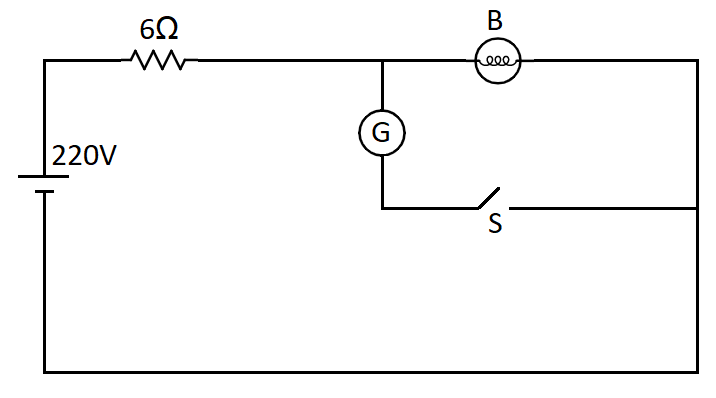Question
Question: The wiring of a house has a resistance \(6\Omega \). A \(100W\), \(200V\) bulb is glowing in the bat...
The wiring of a house has a resistance 6Ω. A 100W, 200V bulb is glowing in the bathroom. A geyser of 1000W, 220V is switched on. The drop in potential across the bulb is:
(A) 0
(B) 24V
(C) 32V
(D) 12V
Solution
We first draw the household circuit where the bulb and the geyser are in parallel. So we calculate the resistance of the bulb and the geyser in the circuit and then can calculate the potential across the bulb in the two cases where the switch is on and off. The difference between these two voltages gives the potential drop.
Formula used: In the solution, we will be using the following formula,
⇒P=RV2
where P is the power
V is the voltage and R is the resistance.
and Req=R1+R2R1×R2
where Req is the equivalent resistance of a parallel circuit.
Complete step by step answer:
For this question, we draw the following circuit

As it is a household circuit so the input voltage is 220V. And the bulb and geyser are connected in parallel as it is a household circuit.
The wiring of the house has a resistance of 6Ω so we can take that resistance as in series with bulb and geyser. So the potential across the bulb will be 220V. So we can find the resistance of the bulb as,
⇒P=RV2, it can be written as
⇒R=PV2
Now for the bulb, P=100W and V=220V. Substituting that value we get the resistance of the bulb as,
⇒Rbulb=100220×220
So calculating we get,
⇒Rbulb=484Ω
For the geyser, the power is, P=1000W and V=220V. Substituting these values we get the resistance of the geyser as,
⇒Rgeyser=1000220×220
So, calculating we get
⇒Rgeyser=48.4Ω
Now, for the first case, when the switch S is open, there is no current flowing through the geyser. So the total current in the circuit is,
⇒I=RtotalV
Here Rtotal is the sum of the resistance of the bulb and the resistance of the wires, given by
⇒Rtotal=484+6=490Ω
So the current in the circuit is,
⇒I=490220=0.449A
Now the potential across the bulb will be Vbulb=IRbulb
Substituting the values we get,
⇒Vbulb=0.449×484 that is equal to, Vbulb=217.3V
For the second case, the switch is on.
Therefore the equivalent resistance will be,
⇒Req=Rbulb+RgeyserRbulb×Rgeyser
Substituting the values we get, Req=484+48.4484×48.4
This is equal to, Req=44Ω
And the total resistance in the circuit is Rtotal=(Req+6)Ω
Substituting the values we get, Rtotal=(44+6)Ω=50Ω
So the current in the circuit in this case is I=50220=4.4A
Therefore the potential across the bulb will be, Vbulb=I×Req
Substituting values, the potential is, Vbulb=4.4×44=193.6V
So the difference in the potential across the bulb will be the potential drop across the bulb.
So, Vdrop=(217.3−193.6)V
So the potential drop across the bulb is Vdrop=23.7V which is equivalent to 24V.
So the correct answer is option (B); 24V.
Note:
In household circuits, the electrical appliances are connected in parallel because this allows every appliance to be switched on and off independently without affecting any other appliance. Moreover, this makes the potential across all the appliances equal to 220V, so the potential drop across every appliance doesn’t affect the power flow to the other appliance.
